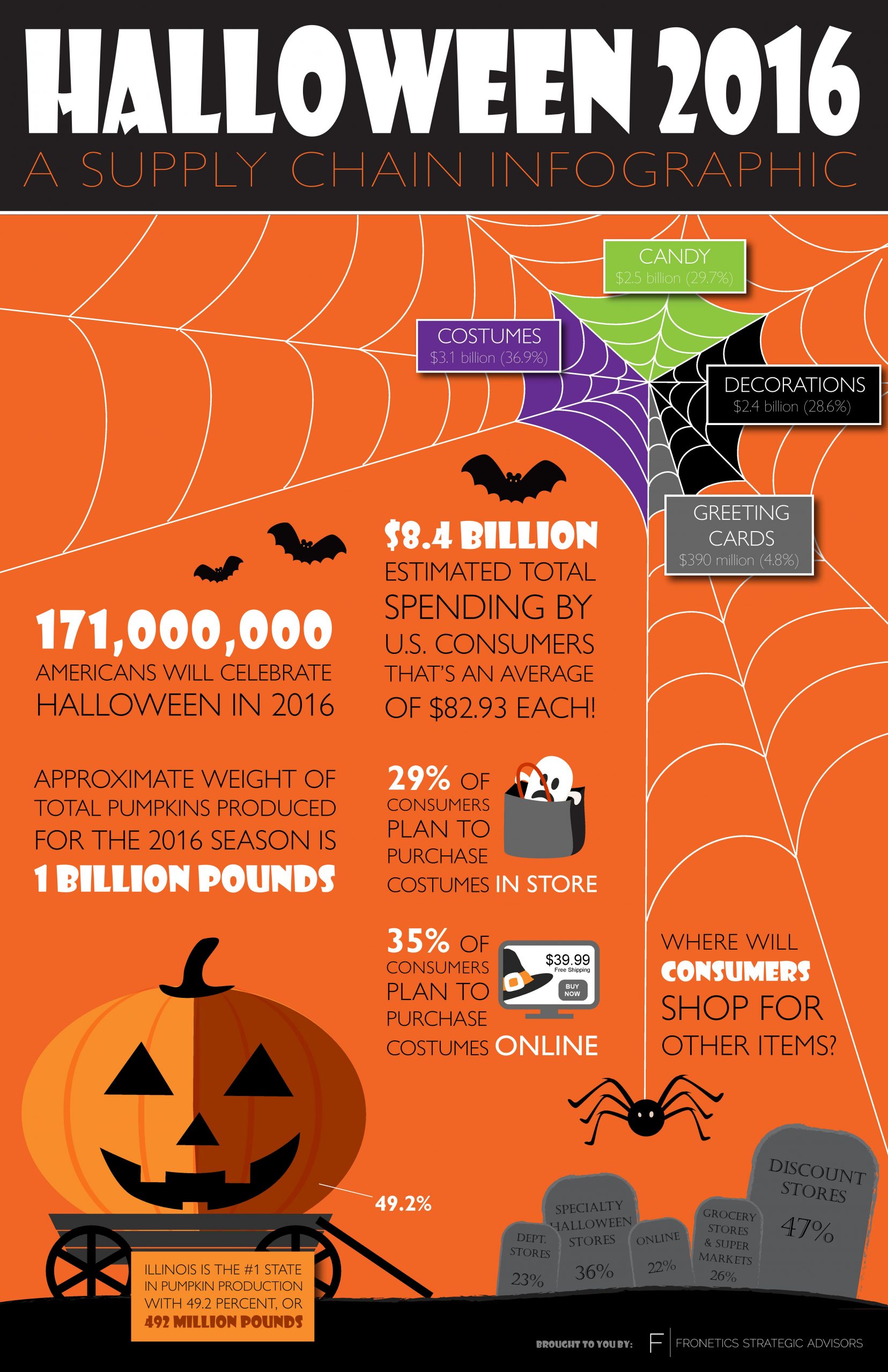
by Fronetics | Oct 31, 2016 | Blog, Current Events, Strategy, Supply Chain
U.S. Consumers plan to spend a whopping $8.4 billion on costumes, candy, decorations, and more to celebrate Halloween 2016.
The National Retail Federation anticipates spending for Halloween 2016 will be at an all-time high.
The NRF’s annual survey found that 171 million Americans will celebrate the holiday, spending a total of $8.4 billion, the most reported in the survey’s 11-year history. Consumers plan to spend an average of $82.93 each, up from last year’s $74.34 per person spending.
As far as costumes go, NRF says to expect zombies, Minions, and characters from Star Wars and Disney’s Frozen to show up at your door. If you’re still looking for ideas yourself, try Pinterest, where 17% of consumers plan to get their inspiration for costumes this year.
Are you one of the 16% who will dress your pet up for Halloween? Take a note from last year’s top 5 pet costumes:
- Pumpkin
- Hot dog
- Batman character
- Devil
- Bumblebee
Check out our infographic of other interesting Halloween 2016 facts from the NRF’s survey of 6,791 consumers below.
Halloween 2016: A supply chain infographic

Related posts:

by Fronetics | Oct 27, 2016 | Blog, Content Marketing, Marketing, Social Media, Strategy
Company X also saw web traffic grow by 180% in 90 days by using Google AdWords and Facebook Ads.
Sometimes our clients can be a little hesitant to try pay-per-click advertising. Take Company X, for example.
Company X’s target customer fits a very particular profile, in terms of geography, income, and age. Because of those specific demographics, the client was not confident that a pay-per-click advertising campaign would be an effective way to reach those target customers. But we thought differently.
When paired with a content marketing program, pay-per-click can be one of the cheapest, in terms of cost-per-lead, and most efficient ways to reach a target audience. Thus, we convinced Company X to try PPC on a trial basis, investing just a small budget.
We developed a strategy for the client, using Google AdWords and Facebook Ads. Over the course of 90 days, the results were phenomenal.
A few key results:
- Company X acquired 54 leads.
- Traffic from paid search grew by 180%.
- The lead-to-customer conversion rate was nearly 3x the industry standard.
Needless to say, Company X will be expanding the use of pay-per-click advertising in the future.
How can pay-per-click help your business?
PPC can seem intimidating to the novice. But, when done right, it can be a highly effective way to reach the very specific kind of customer your business is looking for. A little bit of know-how can be all the difference.
As such, Fronetics has developed a quick training on the basics of pay-per-click advertising: what it is, what platforms are available, etc. If you are interested in learning more about PPC and how it might complement your marketing program, download our free guide below.

Related posts:

by Fronetics | Oct 26, 2016 | Big Data, Blog, Content Marketing, Data/Analytics, Marketing
Big-data insights can help you segment your email database to better target prospects based on where they are in the buyers’ journey.
Most companies these days are swimming in a sea of big data, the great swaths of information they’ve amassed from sales records, social media connections, website leads and contacts, and online analytics.
At first glance it’s a tangle of information that is hard to organize and even harder to learn anything from. That’s a stumbling block that forward-looking businesses need to overcome. Big data can help breathe new life into one of the most reliable yet shopworn tools of the trade: email campaigns.
Embrace Big Data
A study by the executive head-hunting firm Spencer Stuart surveyed 171 companies regarding big-data usage. Just a little over half of the companies used their big data to help guide email, SEO, and SMS marketing campaigns. That’s a fairly low rate, given the potential leg-up that big data can provide.
Consider what Walmart is doing. The company has big-data information on about 60% of all Americans, with which it micro-targets customers based on their individual interests and habits. It’s a powerful strategy that is spreading quickly to businesses of all sizes.
How can you use big data to freshen up your email campaigns?
Be a Collector, Not a Hoarder
Chances are, you are obtaining a lot of data, especially if you have an active content marketing plan in place. Not all of the data you get is equally important. Your focus should be on data that can lead to an actionable and quick response — for example, are you gathering information on your customers’ buying habits? Do you know who they are, where they are, what their interests are, what their email address is, and how your business connects with them?
Collect that relevant data and study it. Much of it will come from the buyer’s journey — the breadcrumbs that potential buyers leave for you in your big data. These pieces of information are keys to your personalized email responses.
Respond In Kind
Most experts agree that a quick and targeted email response is a good strategy for encouraging a new customer to make a purchase. The email needs to respond directly to the buyer’s interests — using information you’ve (hopefully) logged with your big data.
From this point on, it’s crucial to make sure that every email that is sent to that buyer is built around a backbone of big data. Nurture your customers with personalized emails that offer content and deals that line up with their specific interests.
Don’t Mess with the Masses
Mass emails — the generic sales pitch email — used to be the cost-effective and simple way of reaching and converting customers. Now, it’s more than likely they’ll get sent to the trash, or worse, the spam filter. The mass email is your one-way ticket to spam purgatory.
“Traditional methods of mass marketing doesn’t resonate anymore and they’re being ignored by the audience,” said Volker Hildebrand, Global Vice President of Strategy at SAP Hybris, in a recent interview with Forbes. “Data is the fuel for customer engagement, and being able to pull together all the relevant information about in real-time.”
You can do better than the mass email approach. If you’ve collected relevant data and you’ve studied your buyers’ journeys, you have the tools in place to build a smart email campaign. Tailor your campaign to personalize your approach to your customers, and more than likely they’ll open that email.
Related posts:

by Fronetics | Oct 25, 2016 | Blog, Strategy, Talent
A reduced workweek may mean better performance, talent retention, and bigger payoff for employers.
In August 2016, the Washington Post reported that Amazon plans to pilot a program in which select teams will work just 30 hours a week. The teams’ employees will be salaried and receive full benefits, as well as 75% of the pay full-time employees earn. The entire team, including managers, will work on this reduced schedule.
“We want to create a work environment that is tailored to a reduced schedule and still fosters success and career growth,” states an event posting by the company. “This initiative was created with Amazon’s diverse workforce in mind and the realization that the traditional full-time schedule may not be a ‘one size fits all’ model.”
The program comes just a year after a New York Times report depicted Amazon encouraging marathon workweeks while discouraging vacation — and even unfairly evaluating employees in the wake of personal crises like cancer or miscarriages.
Will the new part-time program help combat that image? Will the 30-hour workweek model impact Amazon’s productivity? While Amazon does not plan to roll the program beyond the select teams, research suggests that the company might reap some positive benefits from employees’ working less.
A reduced workweek benefits employees and the employer
Let’s look at how working fewer hours might result in healthier, more productive employees.
1. Shorter hours improve the physical and emotional health of the worker.
A National Bureau of Economic Research study examined manufacturing companies that experienced an unexpected spike in exports, meaning longer working hours, and the resulting toll on employees. The findings revealed that long hours on the job increase an employee’s risk for heart attack, depression, and injury. But despite more health concerns, employees took fewer sick days. The impact on productivity when a company has more sick, injured workers is self-evident.
On the contrary, a shorter workweek correlates with better physical, mental, and emotional well-being. That translates to more alert, adjusted, happy employees who have more stamina to complete their jobs. In fact…
2. A reduced workweek does not decrease productivity — rather, it often increases it.
There’s a reason 43% of companies offer shorter workweeks to some employees: It has a positive impact on their bottom lines. Just how much? Tax services firm Ryan saw revenue and profits almost double and client satisfaction reach an all-time high. KPMG goes as far as to say it uses flexible work hours as a “strategic business tool” that “allows us to accomplish our business goals and become more successful.”
Well employees leading balanced lives are able to accomplish more in a shorter amount of time, and that pays off for their companies.
3. Shorter hours may increase employee engagement and decrease turnover.
All the extra hours workers are putting in actually drive disengagement. Left wholly left unchecked, the culmination of issues arising from an unbalanced work-home life can increase absenteeism and turnover. Simply put, employees logging long hours are significantly more prone to burnout.
And turnover can be costly for employers. The U.S. Department of Labor currently estimates the average cost of a bad hiring decision to be as much as 30% of an individual’s first-year potential earnings. Think about how that adds up as employees put more time with the company and earn higher salaries.
Going back to Ryan, the tax services firm, implementing a shorter workweek reduced the company’s turnover rate from 30% to 11%. That’s huge.
So, Amazon is definitely onto something with its 30-hour workweek experiment. The question is, what will happen when it succeeds? Will more businesses try reducing working hours? Could something like this work for your business?
Related posts:

by Jennifer Hart Yim | Oct 24, 2016 | Blog, Strategy, Supply Chain, Talent
Millennials have a reputation for being lazy and feeling entitled — but what if we got it all wrong?
This guest post comes to us from Argentus Supply Chain Recruiting, a boutique recruitment firm specializing in Supply Chain Management and Procurement.
For the past few years, there’s been a glut of articles about the millennial generation in the workforce. These articles originally focused on how millennials’ perceived laziness and entitlement kept them from securing long-term employment. Coincidentally (or maybe not) these articles first started popping up around 2009-2010, when the great recession made for the toughest jobs climate in decades, especially for young people trying to find their first good jobs out of university — a difficult task for most grads even in a boom economy. Over time (as the economy improved and millennials’ ranks in the workforce began to swell), these millennial-focused articles shifted to discussions of what makes millennials “difficult” to work with. There are a few negative stereotypes that tended to come out of this analysis:
- Millennials ask for raises and promotions constantly.
- Millennials hop around from job to job with little loyalty to their employers.
- Millennials always want to take more vacation time than their superiors.
Of course these stereotypes (like most stereotypes) don’t actually hold up to scrutiny. And in the past couple years it seems as if the business press has finally caught on to the fact that millennials are fitting in and thriving in working culture. Now, companies recognize that this generation offers unique advantages to employers. Millennial-focused analysis has shifted to talking about millennials’ good qualities, including being creative, highly proficient with technology, and excellent multi-taskers.
What millennials aren’t doing
What it comes down to is that companies are now fighting over millennial talent. They’re trying to do all they can to get the star performers to the table. On this topic, we read an interesting piece in the Toronto Star recently — just the latest in the long history of millennial thinkpieces — that bats down one of the nastiest stereotypes about millennial workers. It discusses how new research shows that millennials actually take less vacation than other employees, and tries to tease out the implications of how a seemingly-more “casual” working environment can lead to a chained-to-your-desk working culture.
Interesting stuff.
The article, titled “Millennials Can’t Afford to Keep Skipping Vacation,” discusses the phenomenon of millennial “work martyrs” — people who are afraid to take time off, even if that time off is paid vacation mandated by employment contracts. It cites research from the non-profit U.S. Travel Association that millennials take much, much less time off than stereotypes would dictate. (We should mention that, over the past 15 years, the use of paid vacation days has fallen off a cliff among a lot of different age groups). At Argentus, we try to stay abreast of whatever’s happening in the world of work, so it’s interesting to us think through issues like this.
So what are the implications of this trend?
The article echoes a lot of anxieties about 21st-century white-collar working culture more generally: that in our hyper-connected world, employees are expected to be always working, even when they’re not in the office. Companies reward people based on time commitment rather than productivity. Vacation time might be generously apportioned, or even unlimited, but workers don’t necessarily feel like they can take vacation. The Star article cites an interesting case: in 2015, Kickstarter began offering unlimited paid vacation, but the result was that actual time off taken went down. It appears that workers, especially millennials who are often working more junior, more precarious jobs, won’t take time off unless you tell them to.
Whether this plays out in every company, anxieties about these changes in the workplace are real: They illustrate the importance of work/life balance, which, despite being a buzzword, is also a real concept that pays dividends for employers. Employees who take vacations are not only happier, they’re more productive.
The solution? Maybe companies should start enforcing paid time off instead of rewarding workers who adopt a “work martyr” mentality.
Related posts:

by Fronetics | Oct 20, 2016 | Big Data, Blog, Data/Analytics, Logistics, Manufacturing & Distribution, Strategy, Supply Chain, Warehousing & Materials Handling
These industry leaders are leveraging insights from big data to solve business problems and drive profitable customer action.
Big data is more than just a buzzword: It’s helping companies make big-impact business decisions based on customer behaviors, purchasing patterns, and preferences.
Not all organizations have the resources to invest in big data. But for those that do, the payoff can big significant. The trick, of course, is knowing which numbers to analyze, what can be predicted, how to use big data for your particular business needs.
Let’s look at five big brands that are leveraging big data successfully to drive profitable customer action.
How 5 big brands use big data
1. Amazon
Amazon’s free same-day delivery service, Prime Now, allows Prime members to shop for over 25,000 products that can be delivered to their doorsteps within two hours. How can Amazon accurately predict the specific wants of millions of people across the country at a given time to prepare local inventory for immediate delivery? Aside from efficient warehousing and logistics, the company uses data on purchase history to optimally locate and stock its warehouses. This strategy also helps to reduce the time inventory stays in stock, diminishing working capital requirement.
2. Starbucks
Have you ever wondered how two neighborhood Starbucks locations can both stay in business? The company examines data on local traffic, demographics, and customers to determine the potential success of a new location before expanding. Starbucks can then choose to open a new store where it would be most successful, even if it’s just a few blocks from one of their other locations.
3. Walmart
In preparation for Hurricane Sandy, Walmart analyzed historical sales data before expected inclement weather and found an uptick in sales of flashlights, emergency equipment, and — to everyone’s surprise — strawberry Pop-Tarts in several locations. The company has since leveraged timely analysis of real-time data to drive business performance. As Walmart Senior Statistical Analyst Naveen Peddamail told Forbes: “If you can’t get insights until you’ve analysed your sales for a week or a month, then you’ve lost sales within that time. Our goal is always to get information to our business partners as fast as we can, so they can take action and cut down the turnaround time. It is proactive and reactive analytics.”
4. Rolls-Royce
Rolls-Royce has implemented big data processes in three key areas of their operations: design, manufacture, and after-sales support. Each design simulation for one of their jet engines, for example, generates tens of terabytes of data, which computer systems analyze to determine the viability of the design. The company’s manufacturing systems are increasingly moving toward a networked, Internet of Things (IoT) industrial environment. And after-sales support is completely changed by big-data analysis. Expert engineers continually examine real-time analysis from sensors fitted to all Rolls-Royce engines and propulsion systems to diagnose faults and mitigate issues.
5. Capital One
Big data helps Capital One determine the optimal times to send particular customers certain offers. The team analyzes demographic data and spending habits of their customers to optimize their offerings, which has increased conversion rates on their offers and generated more leads from their marketing budget.
How does your business use big data?
Related posts:








